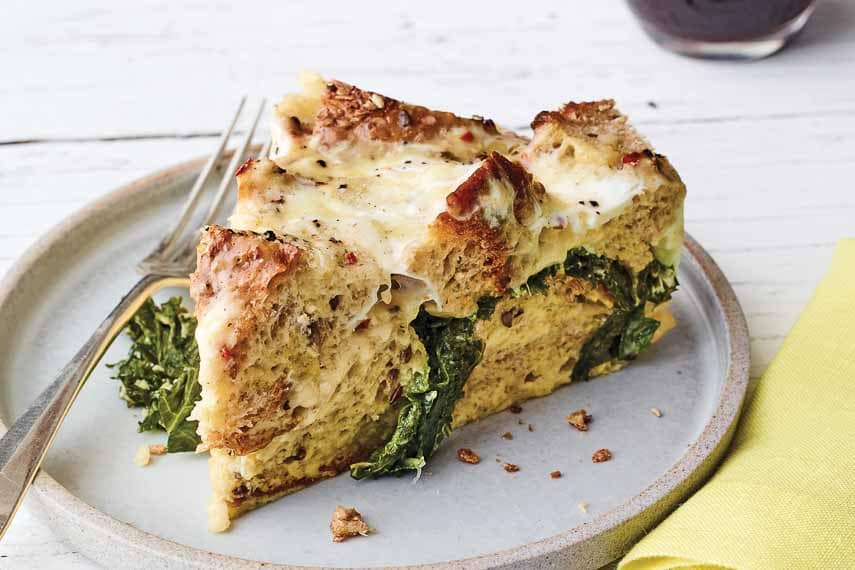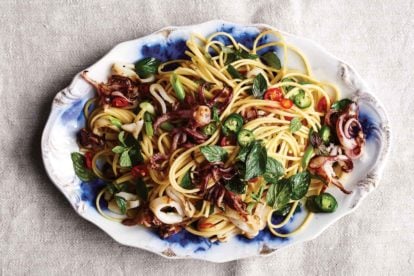A FODMAP IT!™ recipe from Sarah Degregorio’s cookbook
Adventures In Slow Cooking
Note: We received this cookbook from the publisher- but all opinions are our own. This post may include affiliate links. Please see our complete disclosure here.
Go Slow
It snowed this week here in New England and winter is upon us, even if it isn’t official on the calendar. The cold weather makes us think of comfort food and that very often means slow cooked food. Things like roasts and braises, soups and stews in particular. Or maybe, think outside the box and take a look at our Grainy Bread Strata with Kale and Gruyere for a hearty, warming breakfast, brunch or lunch. And it is made in a slow cooker.
Use Your Slow Cooker
The slow cooker does all of these things exceptionally well but is often overlooked when it comes to other types of cooking and baking. That’s where Sarah DiGregorio and her book Adventures in Slow Cooking comes in. The two subtitles say it all: 120 Slow Cooker Recipes for People Who Love Food; Weeknight Dinners, Party Food, Desserts, Cocktails, and More. Yes, even cocktails!
Be Bold, Be Adventurous
Sarah takes us places we haven’t been before with our slow cooker. Recipes like Gingery Chicken and Shiitake Congee, Ricotta-Spinach Polenta with Tomato Salad, Shakshuka with Feta and Olives and Miso-Butter Roast Chicken and Potatoes are ripe for a FODMAP IT!™ approach. This Grainy Bread Strata with Kale and Gruyere was easy to tweak: we just substituted a good quality artisanal low FODMAP sourdough bread and lactose-free milk.
Get It Out of the Closet
If you have a slow cooker around and have been looking for a jolt of creativity, this book is the perfect companion. It will have you looking at this handy machine in a whole new light.
Adapted from Adventures in Slow Cooking by Sarah DiGregorio. Copyright © 2017 by Sarah DiGregorio. Reprinted by permission of William Morrow, an imprint of HarperCollins Publishers.
From Sarah DiGregorio:
This satisfying breakfast casserole walks a line between wholesome (kale, whole grain bread) and indulgent (a lot of cheese). Gruyère (Queen of Cheeses!) melts beautifully and has a nutty, complex flavor. It can be expensive, though, so you could substitute more-affordable fontina or use a mix of the two. I’ve given a range of times and heat levels so that you can make the strata work with your breakfast schedule.

FODMAP IT!™ Grainy Bread Strata with Kale and Gruyere
This FODMAP IT!™ Grainy Bread Strata with Kale and Gruyere is from Sarah DiGregorio's fabulous book, Adventures in Slow Cooking.
Ingredients:
- 10 ounces (280 g) crusty, rustic low FODMAP sourdough bread, cut into 1- to 2-inch (2.5 to 5 cm) cubes (6 to 7 cups/1.4 to 1/7 L)
- 1 bunch (8 to 10 ounces/225 g to 280 g) kale, stemmed
- 10 large eggs beaten
- 2 cups (480 ml) lactose-free whole milk
- 1 teaspoon red pepper flakes
- 2 teaspoons kosher salt
- Freshly ground black pepper
- 12 ounces (340 g) Gruyère, grated (about 3 heaping cups; 720 ml)
Preparation:
-
Preheat the oven to 300˚F/150° Spread the bread pieces on a rimmed baking sheet and toast in the oven for about 30 minutes, until very dry.
-
Meanwhile, prepare a 5- to 7-quart (4.7 L to 6.6 L) slow cooker: Fold a large piece of foil into a 3 x12-inch (7.5 cm to 30.5 cm) strip and press it against the side of the insert that runs the hottest, using the foil like a collar or a shield. The hot spot is probably the wall of the insert opposite (farthest from) the control panel. This will keep that side of the strata from scorching or cooking too quickly. If your slow cooker runs very hot and tends to overbrown on all sides, line the other side with a foil collar as well. Then line the entire insert with 1 piece of parchment, making sure the parchment comes up at least 2 inches (5 cm) on all sides. This is to prevent sticking and also to make it easier to reach in and remove the strata. (You’re using 1 piece of parchment so that the egg mixture doesn’t run between 2 layers of parchment when you pour it in.)
-
Bring a large pot of salted water to a boil. Add the kale leaves, give them a stir, cover, and cook until just wilted, about 1 minute. Drain the kale in a colander, run under cold water to stop the cooking, and thoroughly squeeze the water out with your hands; then blot the kale dry with a kitchen or paper towel. Chop the kale and set it aside.
-
In a medium bowl or large liquid measuring cup, beat together the eggs and milk. Add the red pepper flakes, salt, and a few generous grinds of pepper.
-
Put half the bread pieces into the bottom of the prepared insert. Scatter all the kale and half of the cheese over the top. Add the remaining bread and top with the remaining cheese. Carefully pour the egg mixture all over the top, keeping all the liquid contained in the parchment liner and making sure all the pieces of bread are moistened. Cook until the custard is just set but still jiggly in the middle: on HIGH for 2 hours followed by WARM for 6 hours; on HIGH for 2 hours 30 minutes; or on LOW for 4 hours.
-
Uncover the slow cooker and turn it off. Let the strata rest for 10 minutes. Grabbing the edges of the parchment liner, lift the strata out of the insert. Serve warm or at room temperature, cut into wedges.
-
ALL NIGHT: Holds well on warm through step 5 for up to 30 additional minutes.
Nutrition
All nutritional information is based on third-party calculations and should be considered estimates. Actual nutritional content will vary with brands used, measuring methods, portion sizes and more. For a more detailed explanation, please read our article Understanding The Nutrition Panel Within Our Recipes.










Could you make it in the oven if you don’t have a slow cooker?
Hi Laura, this recipe is from a book that focus on slow-cooker recipes. The recipe developer/author did not provide alternative cooking methods, nor have we tried it. I would recommend following the recipe as written, or try a recipe specifically developed for oven cooking. There is just too much that would change for me to suggest that you would have success and we would hate for you to waste time and ingredients.